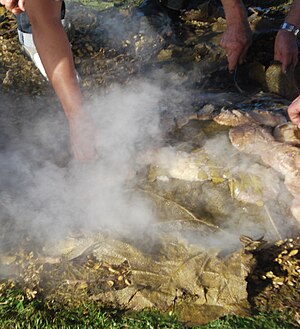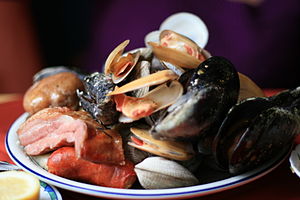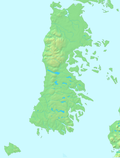Curanto
 Uncovering the curanto in Calen, commune of Dalcahue, Chiloé, Chile | |
| Place of origin | Chile |
|---|---|
| Region or state | Chiloé |
| Serving temperature | Hot |
| Main ingredients | Potatoes, shellfish, meat |
| Variations | Multiple |
Curanto is a traditional food of Chiloé Archipelago that has spread to the southern areas of Chile and Argentina, whose remains dated back about 11,525 ± 90 uncalibrated years before present.[1] It consists of seafood, meat, potatoes and vegetables and is traditionally prepared in a hole, about a meter and a half (approx. one and a half yards) deep, which is dug in the ground. The bottom is covered with stones, heated in a bonfire until red.[2]
Preparation[]
The ingredients consist of shellfish, meat, potatoes, milcao (a kind of potato pancake), chapaleles (a kind of potato dumpling), and vegetables. Curanto sometimes also includes specific types of fish. The varieties of shellfish vary but almejas (clams), cholgas (ribbed mussels) and picorocos (giant barnacles) are essential. The quantities are not fixed; the idea is that there should be a little of everything. Each layer of ingredients is covered with nalca (Chilean rhubarb) leaves, or in their absence, with fig leaves or white cabbage leaves. All this is covered with wet sacks, and then with dirt and grass chunks, creating the effect of a giant pressure cooker in which the food cooks for approximately one hour.[2]
Curanto can also be prepared in a large stew pot that is heated over a bonfire or grill or in a pressure cooker. This stewed curanto is called "curanto en olla" or "pulmay" in the central region of Chile.
History[]

It is believed that this form of preparing foods was native to the "chono" countryside and that, with the arrival of the southern peoples and the Spanish conquistadors, new ingredients were added until it came to be the curanto that is known today.
See also[]
- Earth oven
- Pachamanca (Perú)
- Hangi (New Zealand)
- Kalua (Hawaii)
- Clam bake (New England)
References[]
- ^ Rivas, Pilar; Ocampo, Carlos (2002). "El antiguo curanto chilote". Fondecyt 1020616 “Proceso y orígenes del poblamiento marítimo de los canales patagónicos: Chiloé y el núcleo septentrional" (in Spanish).
- ^ a b "The curanto". ThinkQuest. Archived from the original on 2013-06-24. Retrieved 2013-01-02.
External links[]
| Wikimedia Commons has media related to Curanto. |
- Chilean cuisine
- Earth oven
- Chiloé Archipelago
- Seafood dishes
- Meat dishes
